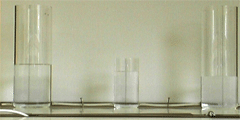| 5 | Accounting for liquids in three tanks |
|
|
| Main | Three tanks are connected in series by hoses. A small tanks stands between two larger ones. Different quantities of water are filled into the tanks, the water is allowed to flow. During the process, data of levels is taken. More…

|
Photographs | Ten photos of the process, intervals of 25 seconds: |
| Movies |

|
| Data files | Data from Movie 2: |
| Models | |
| |
| Sections | |
|
| |
| Description | DESCRIPTION OF EXPERIMENT |
| Experiment | Three tanks are connected in series by hoses. A small tanks stands between two larger ones. Different quantities of water are filled into the tanks, the water is allowed to flow. During the process, data of levels is taken.

|
| Dimensions | Radius of Tank 1: 0.075 m Radius of Tank 2: 0.050 m Radius of Tank 3: 0.075 m |
| |
| Sections | |
|
| |
| Assignment | A POSSIBLE PATH THROUGH THE INVESTIGATION… |
| Basics | Investigate the experiment, make sure you understand the setup of the system and the initial conditions. Plot the data to get an impression of the processes taking place. Explain what is happening to the quantities of water in the tanks.

|
Particulars | Determine the volumes of water in the three tanks from the level data. Use the volumes to determine the rates of change of volume in the three tanks. Use the rates of change of volume to determine the flows through the connecting tubes. Use the flows to determine the volume of water in the middle tank as a function of time. Compare your calculation to the measured volume. |
| |
| Sections | |
|
| |
| Model | MODEL EQUATIONS AND MORE… |
| |
|
| |
| Sections | |
|
| |
| Questions | SOME SIMPLE QUESTIONS… |
| 1 | Observation of the processes (such as in a movie) allow us to easily determine levels of liquids in tanks. How do you determine volumes of liquid from these observations? |
2 | Is the volume of water in any of the tanks constant? Why or why not? Does the total volume of water stay constant during the process? Why or why not? |
3 | Assuming that the total volume of water stays constant during the process of flow, how many observations of volumes have to be made, and how many (not observed) volumes can be predicted using this assumption? |
4 | From the observation of the process, would you say that any of the flows of water reverses its direction (sign)? If so, which one and why? |
5 | The level of water in the tank on the right reaches a minimum at some point. What is the rate of change of volume of water in the tank at that point? Does does this mean about the flow (or flows) of water into or out of the tank at that moment? |
|
| |
| Sections | |
|
| |


